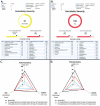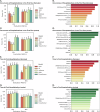Next-generation precision medicine for suicidality prevention
- PMID: 39242534
- PMCID: PMC11379963
- DOI: 10.1038/s41398-024-03071-y
Next-generation precision medicine for suicidality prevention
Abstract
Suicidality remains a clear and present danger in society in general, and for mental health patients in particular. Lack of widespread use of objective and/or quantitative information has hampered treatment and prevention efforts. Suicidality is a spectrum of severity from vague thoughts that life is not worth living, to ideation, plans, attempts, and completion. Blood biomarkers that track suicidality risk provide a window into the biology of suicidality, as well as could help with assessment and treatment. Previous studies by us were positive. Here we describe new studies we conducted transdiagnostically in psychiatric patients, starting with the whole genome, to expand the identification, prioritization, validation and testing of blood gene expression biomarkers for suicidality, using a multiple independent cohorts design. We found new as well as previously known biomarkers that were predictive of high suicidality states, and of future psychiatric hospitalizations related to them, using cross-sectional and longitudinal approaches. The overall top increased in expression biomarker was SLC6A4, the serotonin transporter. The top decreased biomarker was TINF2, a gene whose mutations result in very short telomeres. The top biological pathways were related to apoptosis. The top upstream regulator was prednisolone. Taken together, our data supports the possibility that biologically, suicidality is an extreme stress-driven form of active aging/death. Consistent with that, the top subtypes of suicidality identified by us just based on clinical measures had high stress and high anxiety. Top therapeutic matches overall were lithium, clozapine and ketamine, with lithium stronger in females and clozapine stronger in males. Drug repurposing bioinformatic analyses identified the potential of renin-angiotensin system modulators and of cyclooxygenase inhibitors. Additionally, we show how patient reports for doctors would look based on blood biomarkers testing, personalized by gender. We also integrated with the blood biomarker testing social determinants and psychological measures (CFI-S, suicidal ideation), showing synergy. Lastly, we compared that to machine learning approaches, to optimize predictive ability and identify key features. We propose that our findings and comprehensive approach can have transformative clinical utility.
© 2024. The Author(s).
Conflict of interest statement
ABN is listed as inventor on patent applications filed by Indiana University. ABN and AS are co-founders, SMK is a consultant, SSG is a part-time employee and MS is a full-time employee of MindX Sciences.
Figures



References
MeSH terms
Substances
Grants and funding
- 2I01CX000139/U.S. Department of Veterans Affairs (Department of Veterans Affairs)
- R01 MH117431/MH/NIMH NIH HHS/United States
- R01MH117431/U.S. Department of Health & Human Services | NIH | National Institute of Mental Health (NIMH)
- I01 CX002094/CX/CSRD VA/United States
- I01 CX000139/CX/CSRD VA/United States
LinkOut - more resources
Full Text Sources
Medical
Miscellaneous

